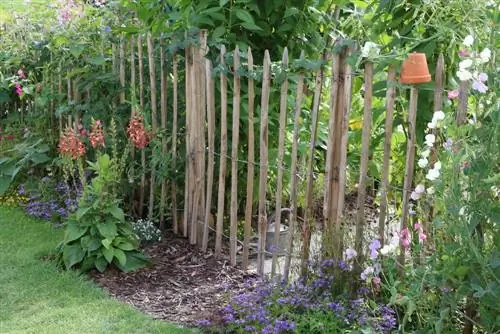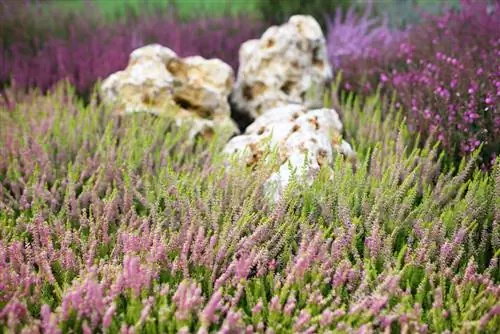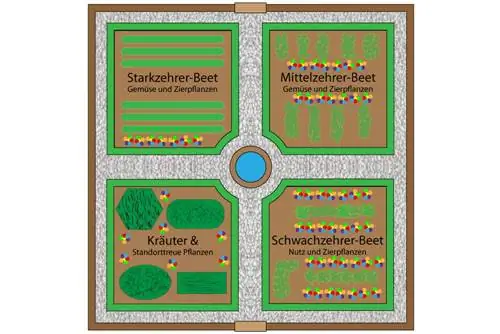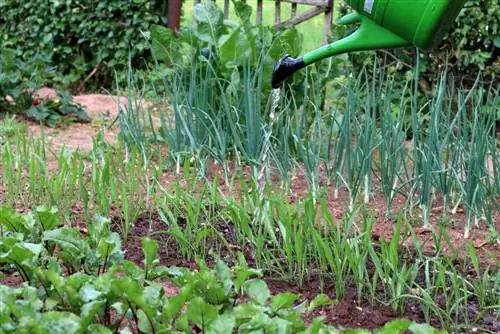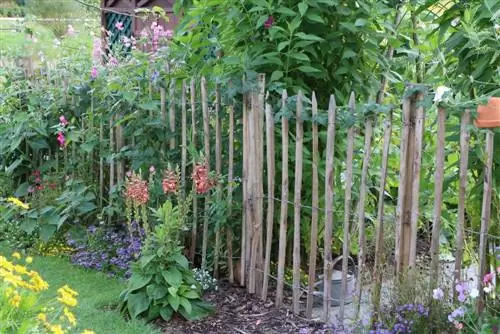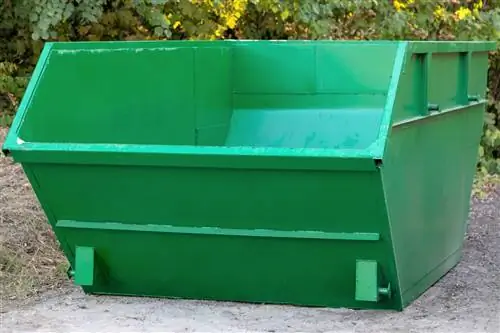- Author admin [email protected].
- Public 2023-12-17 03:39.
- Last modified 2025-01-24 12:45.
The term cottage garden is surrounded by the aura of romance and closeness to nature. But what exactly does the term mean? When you search for an answer, you are denied a clear-cut, clear definition. The nostalgic garden style becomes more tangible when we take a look at its historical development. In fact, the cottage garden underwent a change on the way from the Middle Ages to modernity, so that it corresponds better to the spirit of the times today than many avant-garde garden concepts. Read here what goes into an authentic farm garden.
Historical developments shed light on the darkness
The vast majority of garden concepts are based on a clear definition. A prime example are the Japanese Gardens, which are designed according to precise specifications. This does not apply to the cottage garden. Here you will encounter a mature garden form that has emerged from a long, historical development. The better you are familiar with this history, the more stylishly you will be able to create your individual and authentic farm garden.
Germanic tribes took the first step
The garden had its origins under the Germanic peoples. Here a piece of agricultural land was enclosed in order to cultivate garden plants that were used as food, medicinal herbs and to drive away evil spirits. The focal point was the elder bush, which our ancestors said had magical powers. Peas, beans, beets and grain were also grown, as well as at least one apple tree. Since the fields, meadows and forests were the property of the general public at that time, fencing in the original garden was of great importance. The woven fence should not only keep wildlife away from the plants. At the same time, the farming family signaled that this marked, fenced piece of land was their private property.
Romans bring color to the cottage garden
The unadorned, drab cottage gardens of the Germanic tribes were a thorn in the side of the Romans. When they took over rule after the turn of the century, they not only brought Mediterranean herbs and fruits with them, such as dill, mustard, aniseed, plums, peaches, almonds and grape vines. At the same time, the conquerors advocated the inclusion of decorative elements in garden design, such as lilies, roses and other flowers, which should appear colorful alongside cucumbers, celery and pumpkin. However, the practical Germanic people followed these instructions only very hesitantly.
Monastery gardens impress with their sophisticated concept
The migration of peoples from the 2nd to 6th centuries AD put an end to these initial approaches well into the Middle Ages. It was only in the time of Charlemagne that German garden culture picked up speed again with the Capitulare de villis vel curtis imperii estate ordinance. The magnificent monastery gardens that were created at the same time with their well thought-out and effective concept aroused the interest of the farmers. In particular, the St. Gallen monastery plan (826 - 830) served as a practical template for them to create their own gardens, which also produced bountiful harvests in a limited area. The four supporting pillars of the medieval cottage garden still exist today:
- The Garden of the Great Cloister
- The Orchard
- The herb garden
- The Vegetable Garden
Since the farmers were forced to use their fertile land extremely sparingly, these four monastery gardens were quickly combined into a single garden. Elements such as crossroads, center, fruit trees, vegetable and herb plants and flowers still define the basic concept of an authentic cottage garden to this day. Also preserved are the fencing of the entire area as well as flowerbed borders with which the medieval farmers wanted to keep the devil and evil spirits away.
Historical floor plan still applies
In the modern cottage garden, self-sufficiency takes a back seat as a central function. Today, the desire for a decorative appearance combined with carefree snacking pleasure, based on ecologically oriented management, dominates. The original floor plan, which began in the medieval monastery gardens, has been preserved for implementation. How it works is incredibly simple:
- Focus is formed by 4 square beds
- 3 beds for vegetables and 1 bed for herbs and medicinal plants
- The beds are arranged around a large crossroads
- A roundel, fountain or fruit tree serves as the center
- A circular path and the fence mark the border to the outside
A distance of 60 cm to 100 cm is maintained between the surrounding path and the fence. There is enough space for berry bushes, rhubarb, compost and seating. Flowers are integrated everywhere in the farm garden. They can also be found between vegetables and herb plants, as well as in the center or in the space between the path and the fence.
Tip:
So that the planting time can be used optimally in spring, the planning work for the cottage garden should be completed at the end of winter.
This belongs in the authentic cottage garden

Since there was never a standard type of cottage garden, you have flexible options for individual design. If you want to largely preserve the old traditions, the following components - in addition to the floor plan - are crucial for an original appearance.
Imaginative enclosures
How you actually build the fence depends on various criteria, such as a sense of style, craftsmanship, time capacity and of course the financial budget. The following variants have proven to be popular:
- An untreated picket fence
- An original wicker fence
- A natural picket fence
- A natural stone wall
- A flowering or evergreen hedge
If you choose a wooden fence, flowering fence peepers give it a romantic touch. The focus is on climbing and tendriling plants, such as hollyhocks (Alcea), tall delphiniums (Delphinium elatum) or clematis (Clematis).
Tip:
Saving hobby gardeners fence the cottage garden with an inexpensive chain-link fence, which is quickly hidden from view by fast-growing climbing plants.
Bed borders in harmony with nature
Since mixed culture reigns in the original cottage garden with the associated natural chaos, bed borders ensure order and underline the symmetrical arrangement. Furthermore, the local border prevents plants from different beds from conquering the garden. Buxus traditionally takes on this task. Since the boxwood borer drove these trees to the brink of ruin, the following plant species have come into focus:
- Carnation
- Lavender (Lavandula officinalis)
- Blue cushion (Aubrieta)
- Purple chives (Allium schoenoprasum 'Forescate')
- Stonewort (Alyssum)
- Tagetes (Tagetes)
This short list names just a few of the numerous plant species that are suitable for bordering beds in the cottage garden. It is important to note that these are small plants that grow up to a maximum of 50 cm in height or are suitable for cutting. Alternatively, border the beds with a small wicker fence, wooden posts stuck upright in the ground or a low dry stone wall.
Tip:
A cottage garden only meets high expectations if it is in a sunny to semi-shady location. The vast majority of typical plants also prefer a nutrient-rich, humus-rich, permeable soil, fresh-moist to moderately dry and with a pH value of around 6.5.
Sophisticated path system
The crossroads determine the arrangement of the paths. It is obvious that concrete or asph alt are taboo as surfaces. Instead, materials are used that allow rain to pass through and are easy to drive over with a wheelbarrow. Bark mulch is ideal for this purpose. Pine bark has a more decorative effect, but this comes with a higher price. Ornamental gravel is also often found in cottage gardens. Naturally beautiful, lawn appears as a path surface interspersed with individual natural stone slabs.
So that you can carry out the necessary maintenance work without hindrance, the paths in the cottage garden should be 60 to 100 cm wide. If every bed can be easily reached from all sides with the wheelbarrow, you have done everything right.
Natural snack garden with a decorative touch
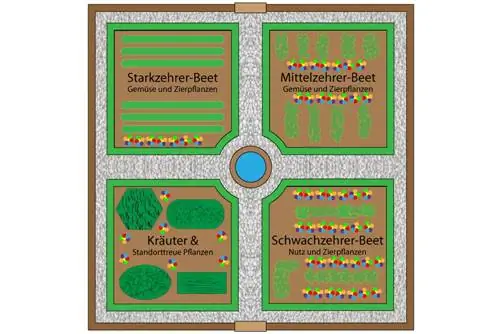
The division of the farm garden into 4 beds is based on the consideration of planting according to heavy feeders, medium feeders and weak feeders as well as a bed for herbs and medicinal plants. The arrangement is completed by berry bushes, which are located between the fence and the surrounding route to work. At this point, the original planting for the vital self-sufficiency of the Middle Ages flows into a modern cottage garden concept as a decorative snack garden in mixed culture. For your inspiration, we have put together recommended ornamental and useful plants for each bed below that correspond to the idea of the cottage garden:
Heavy feeder bed
The first bed is intended for heavy-feeding vegetable and ornamental plants that take a long time to grow. The following selection gives a representative insight into what should grow and thrive in the cottage garden in this location:
- Pumpkin (Cucurbita ssp.)
- Kohlrabi (Brassica oleracea var. gongylodes)
- Potatoes (Solanum tuberosum)
- Melons (Cucumis melo
- Tomatoes (Solanum lycopersicum)
- Broccoli (Brassica oleracea
- Cucumis (Cucumis sativus)
Chrysanthemums (Chrysanthemum), geraniums (Geranium), sunflowers (Helianthus), delphiniums (Consolida ajacis) or the magnificent coneflower (Echinacea purpurea) provide variety in appearance.
Mittelzehrer bed
This bed offers space for the medium-eating plants among your favorite garden plants. Suitable candidates for a feast for the palate and eyes are:
- Chicory (Cichorium intybus)
- Endive (Cichorium endivia)
- Carrots (Daucus carota subsp. sativus)
- Leek (Allium ampeloprasum subsp. ampeloprasum)
- Lettuce (Lactuca sativa)
- Spinach (Spinacia oleracea)
For cheerful, bright colors, place purple bells (Heuchera), bergenias (Bergenia cordifolia), glories (Stipa barbata) or blue monkshood (Aconitum napellus) between the crops.
Weak eater bed
The selection of low-feeding crops and ornamental plants is significantly more limited than for heavy and weak feeders. The following plant species are considered:
- Bush bean (Phaseolus vulgaris ssp.vulgaris var. nanus)
- Lamb lettuce (Valerianella ssp.)
- Peas (Pisum sativum)
- Radish (Raphanus sativus var. sativus)
- Purslane (Portulaca oleracea)
To make this bed colorful, plant goose cress (Arabis caucasica) in between, supplemented with asters (Aster), carnations (Armeria maritima) or porcelain flowers (Saxifraga umbrosa).
Herbs and site-faithful plants
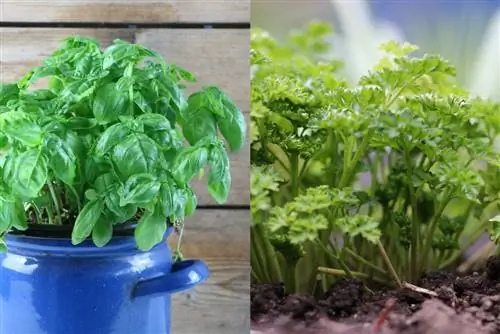
The fourth bed offers the opportunity to plant herbs as well as plants that are true to the location. The following species are the focus of interest at this point:
- Parsley (Petroselinum crispum)
- Chives (Allium schoenoprasum)
- Basil (Ocimum basilicum)
- Strawberries (Fragaria ssp.)
- Asparagus (Asparagus)
- Rhubarb (Rheum hybridum)
There is also the option of planting berry bushes in this bed. Home gardeners like to choose this alternative when fruit trees and fence peepers get in the way in the outdoor area of the cottage garden. Since some of the berry bushes bloom beautifully at the same time, this option is worth considering. The shortlist includes currants (Ribes), raspberries (Rubus idaeus), gooseberries (Ribes uva-crispa) and blackberries (Rubus sectio Rubus).
Decorative elements with added value
The love of nature is very important in the modern cottage garden. If decorative elements are integrated into the design plan, they not only serve as decoration, but also fulfill an environmentally friendly purpose. Fence posts, for example, are decorated with upturned ceramic pots. These are filled with wood shavings to provide a place for beetles and other beneficial insects to retreat. Rotten tree trunks or piles of leaves point in a similar direction.
To turn the center of the farm garden into a nature-loving eye-catcher, the roundel is planted with flowering butterfly and bee willows. If you decide on a rose circle, use nectar-rich flowers, such as nasturtiums, as underplanting. A creative and sensible idea for the centerpiece of the cottage garden is the herb spiral. This creates space in the fourth bed without sacrificing the aromatic kitchen and medicinal plants.
Conclusion
There is no quick answer to the question of what a cottage garden actually is. In order to fully understand this popular garden style and realize it authentically, a look at its history brings clarity. Emerging from the monastery gardens of the Middle Ages, the concept underwent numerous modifications on its way into the modern era. The floor plan with four beds and a cloister as well as a natural enclosure have been preserved. Based on a mixed culture, the planting plan today is no longer aimed at self-sufficiency, but rather aims at a decorative combination of snack garden and flower borders.

